TPMS Alfa Romeo 4C 2020 Owner handbook (in English)
[x] Cancel search | Manufacturer: ALFA ROMEO, Model Year: 2020, Model line: 4C, Model: Alfa Romeo 4C 2020Pages: 156, PDF Size: 3.06 MB
Page 40 of 156
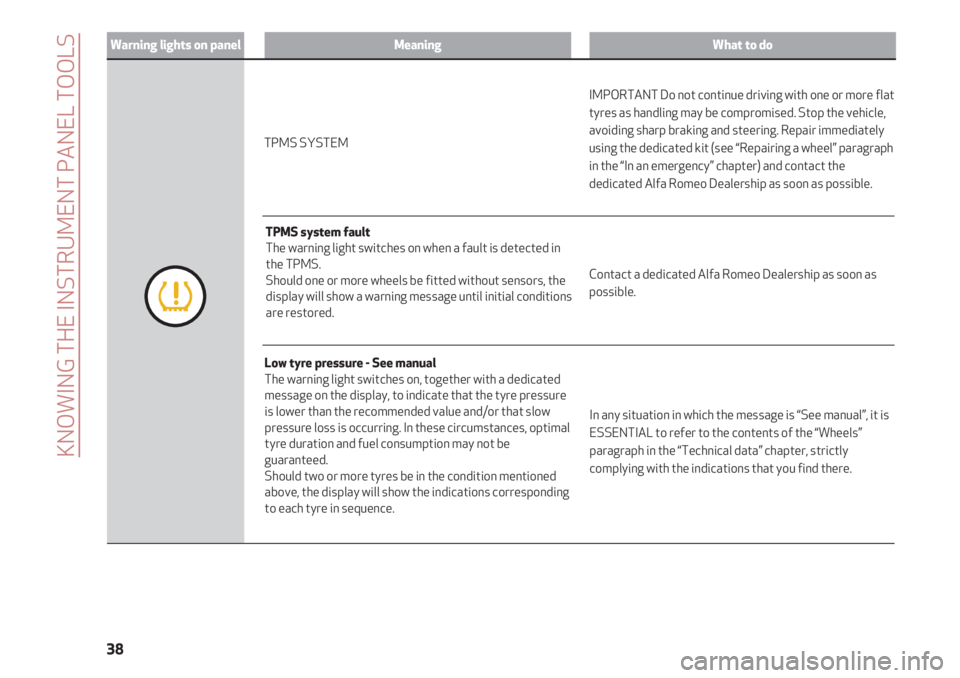
KNOWING THE INSTRUMENT PANEL TOOLS
38
Warning lights on panelMeaningWhat to do
In any situation in which the message is “See manual”, it is
ESSENTIAL to refer to the contents of the “Wheels”
paragraph in the “Technical data” chapter, strictly
complying with the indications that you find there.
Low tyre pressure - See manual
The warning light switches on, together with a dedicated
message on the display, to indicate that the tyre pressure
is lower than the recommended value and/or that slow
pressure loss is occurring. In these circumstances, optimal
tyre duration and fuel consumption may not be
guaranteed.
Should two or more tyres be in the condition mentioned
above, the display will show the indications corresponding
to each tyre in sequence.
Contact a dedicated Alfa Romeo Dealership as soon as
possible. TPMS system fault
The warning light switches on when a fault is detected in
the TPMS.
Should one or more wheels be fitted without sensors, the
display will show a warning message until initial conditions
are restored.IMPORTANT Do not continue driving with one or more flat
tyres as handling may be compromised. Stop the vehicle,
avoiding sharp braking and steering. Repair immediately
using the dedicated kit (see “Repairing a wheel” paragraph
in the “In an emergency” chapter) and contact the
dedicated Alfa Romeo Dealership as soon as possible. TPMS SYSTEM
Page 51 of 156
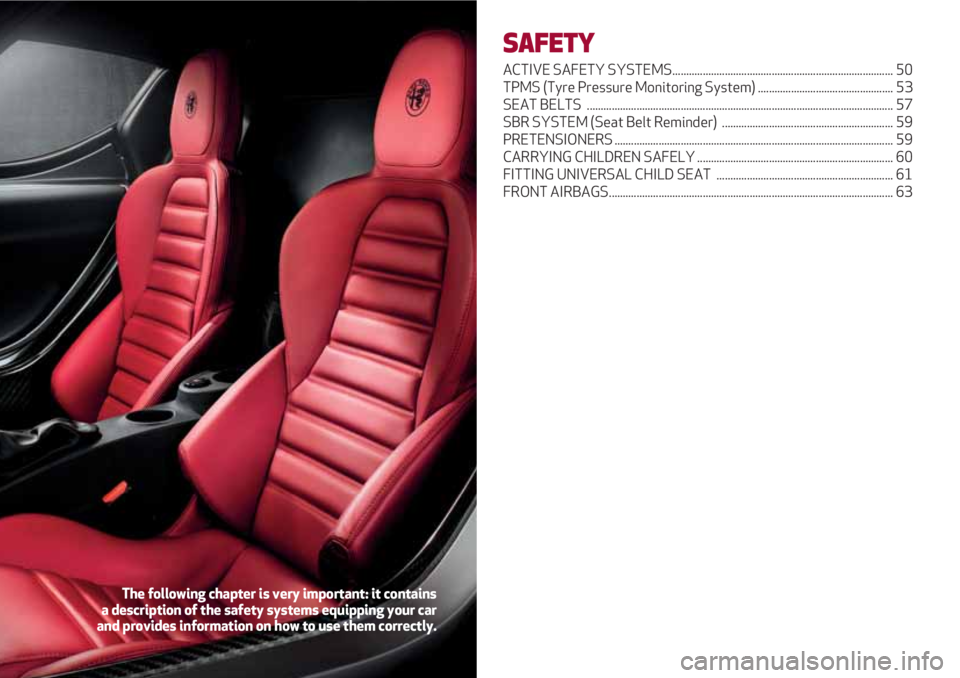
SAFETY
ACTIVE SAFETY SYSTEMS................................................................................ 50
TPMS (Tyre Pressure Monitoring System) ................................................. 53
SEAT BELTS ............................................................................................................... 57
SBR SYSTEM (Seat Belt Reminder) .............................................................. 59
PRETENSIONERS ..................................................................................................... 59
CARRYING CHILDREN SAFELY ....................................................................... 60
FITTING UNIVERSAL CHILD SEAT ................................................................ 61
FRONT AIRBAGS....................................................................................................... 63
The following chapter is very important: it contains
a description of the safety systems equipping your car
and provides information on how to use them correctly.
Page 55 of 156
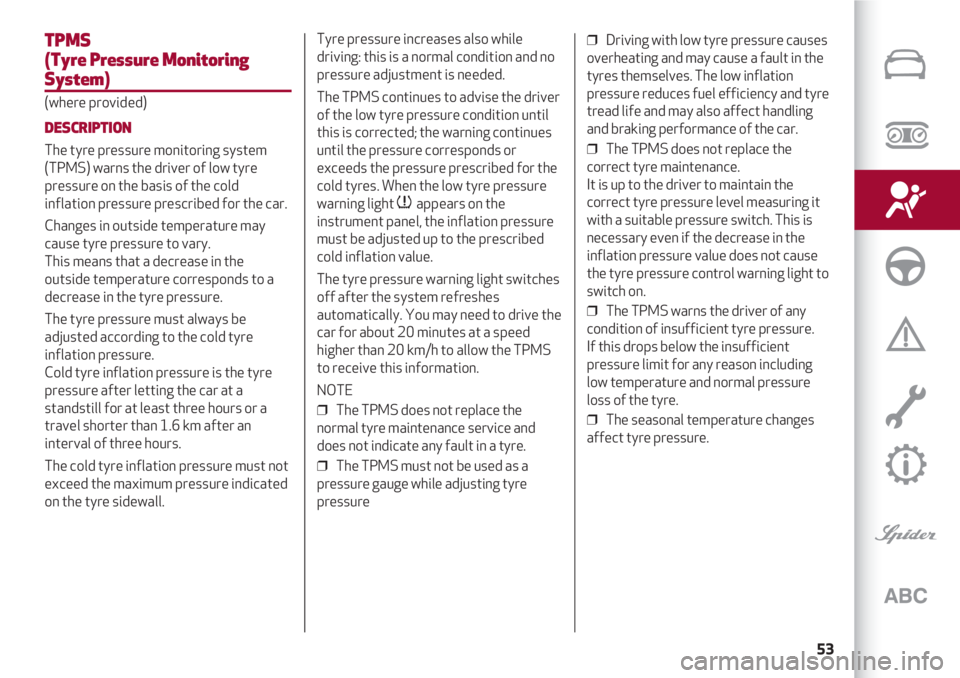
53
TPMS
(Tyre Pressure Monitoring
System)
(where provided)
DESCRIPTION
The tyre pressure monitoring system
(TPMS) warns the driver of low tyre
pressure on the basis of the cold
inflation pressure prescribed for the car.
Changes in outside temperature may
cause tyre pressure to vary.
This means that a decrease in the
outside temperature corresponds to a
decrease in the tyre pressure.
The tyre pressure must always be
adjusted according to the cold tyre
inflation pressure.
Cold tyre inflation pressure is the tyre
pressure after letting the car at a
standstill for at least three hours or a
travel shorter than 1.6 km after an
interval of three hours.
The cold tyre inflation pressure must not
exceed the maximum pressure indicated
on the tyre sidewall.Tyre pressure increases also while
driving: this is a normal condition and no
pressure adjustment is needed.
The TPMS continues to advise the driver
of the low tyre pressure condition until
this is corrected; the warning continues
until the pressure corresponds or
exceeds the pressure prescribed for the
cold tyres. When the low tyre pressure
warning light
nappears on the
instrument panel, the inflation pressure
must be adjusted up to the prescribed
cold inflation value.
The tyre pressure warning light switches
off after the system refreshes
automatically. You may need to drive the
car for about 20 minutes at a speed
higher than 20 km/h to allow the TPMS
to receive this information.
NOTE
❒ The TPMS does not replace the
normal tyre maintenance service and
does not indicate any fault in a tyre.
❒ The TPMS must not be used as a
pressure gauge while adjusting tyre
pressure❒ Driving with low tyre pressure causes
overheating and may cause a fault in the
tyres themselves. The low inflation
pressure reduces fuel efficiency and tyre
tread life and may also affect handling
and braking performance of the car.
❒ The TPMS does not replace the
correct tyre maintenance.
It is up to the driver to maintain the
correct tyre pressure level measuring it
with a suitable pressure switch. This is
necessary even if the decrease in the
inflation pressure value does not cause
the tyre pressure control warning light to
switch on.
❒ The TPMS warns the driver of any
condition of insufficient tyre pressure.
If this drops below the insufficient
pressure limit for any reason including
low temperature and normal pressure
loss of the tyre.
❒ The seasonal temperature changes
affect tyre pressure.
Page 56 of 156
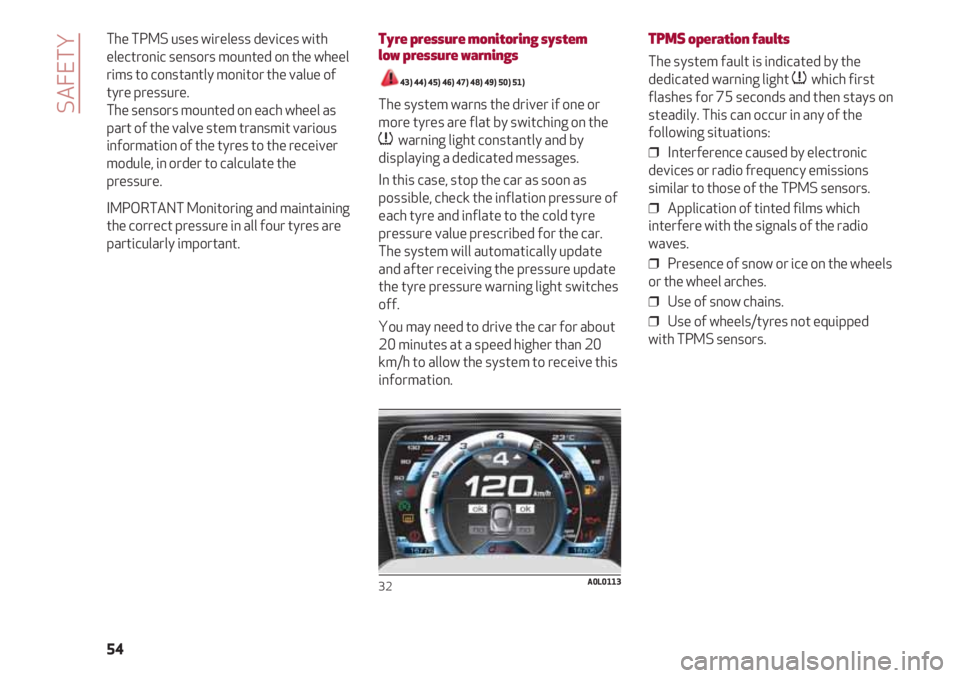
SAFETY
54 The TPMS uses wireless devices with
electronic sensors mounted on the wheel
rims to constantly monitor the value of
tyre pressure.
The sensors mounted on each wheel as
part of the valve stem transmit various
information of the tyres to the receiver
module, in order to calculate the
pressure.
IMPORTANT Monitoring and maintaining
the correct pressure in all four tyres are
particularly important.
Tyre pressure monitoring system
low pressure warnings
43) 44) 45) 46) 47) 48) 49) 50) 51)
The system warns the driver if one or
more tyres are flat by switching on the
nwarning light constantly and by
displaying a dedicated messages.
In this case, stop the car as soon as
possible, check the inflation pressure of
each tyre and inflate to the cold tyre
pressure value prescribed for the car.
The system will automatically update
and after receiving the pressure update
the tyre pressure warning light switches
off.
You may need to drive the car for about
20 minutes at a speed higher than 20
km/h to allow the system to receive this
information.
32A0L0113
TPMS operation faults
The system fault is indicated by the
dedicated warning light
nwhich first
flashes for 75 seconds and then stays on
steadily. This can occur in any of the
following situations:
❒ Interference caused by electronic
devices or radio frequency emissions
similar to those of the TPMS sensors.
❒ Application of tinted films which
interfere with the signals of the radio
waves.
❒ Presence of snow or ice on the wheels
or the wheel arches.
❒ Use of snow chains.
❒ Use of wheels/tyres not equipped
with TPMS sensors.
Page 58 of 156
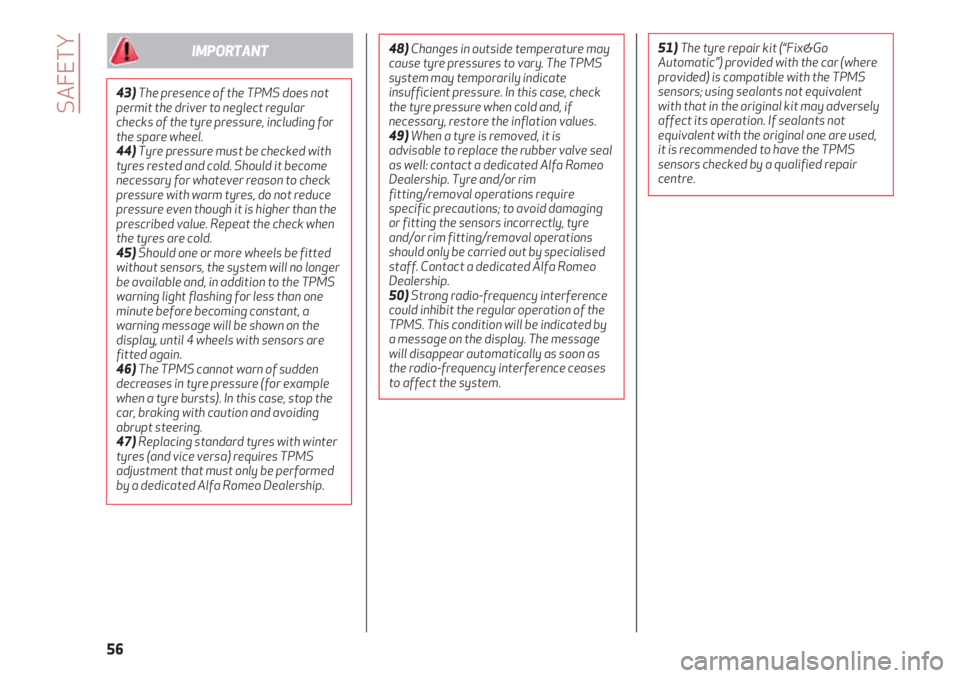
SAFETY
56
43)The presence of the TPMS does not
permit the driver to neglect regular
checks of the tyre pressure, including for
the spare wheel.
44)Tyre pressure must be checked with
tyres rested and cold. Should it become
necessary for whatever reason to check
pressure with warm tyres, do not reduce
pressure even though it is higher than the
prescribed value. Repeat the check when
the tyres are cold.
45)Should one or more wheels be fitted
without sensors, the system will no longer
be available and, in addition to the TPMS
warning light flashing for less than one
minute before becoming constant, a
warning message will be shown on the
display, until 4 wheels with sensors are
fitted again.
46)The TPMS cannot warn of sudden
decreases in tyre pressure (for example
when a tyre bursts). In this case, stop the
car, braking with caution and avoiding
abrupt steering.
47)Replacing standard tyres with winter
tyres (and vice versa) requires TPMS
adjustment that must only be performed
by a dedicated Alfa Romeo Dealership.
IMPORTANT48)Changes in outside temperature may
cause tyre pressures to vary. The TPMS
system may temporarily indicate
insufficient pressure. In this case, check
the tyre pressure when cold and, if
necessary, restore the inflation values.
49)When a tyre is removed, it is
advisable to replace the rubber valve seal
as well: contact a dedicated Alfa Romeo
Dealership. Tyre and/or rim
fitting/removal operations require
specific precautions; to avoid damaging
or fitting the sensors incorrectly, tyre
and/or rim fitting/removal operations
should only be carried out by specialised
staff. Contact a dedicated Alfa Romeo
Dealership.
50)Strong radio-frequency interference
could inhibit the regular operation of the
TPMS. This condition will be indicated by
a message on the display. The message
will disappear automatically as soon as
the radio-frequency interference ceases
to affect the system.51)The tyre repair kit (“Fix&Go
Automatic”) provided with the car (where
provided) is compatible with the TPMS
sensors; using sealants not equivalent
with that in the original kit may adversely
affect its operation. If sealants not
equivalent with the original one are used,
it is recommended to have the TPMS
sensors checked by a qualified repair
centre.
Page 153 of 156

151
Paint (identification plate) ....................121
Parking lights ..................................................17
Parking sensors .............................................77
Parking ................................................................69
handbrake ...................................................69
Passenger side front airbag
and child restraint systems ......................64
Passenger side front airbag .....................64
Performance ................................................132
Power windows ..............................................23
Pre-Fill (RAB - Ready Alert Brake)
system .................................................................52
Pretensioners ..................................................59
load limiters ..............................................60
Raising the car ............................................114
Read this carefully............................................2
Rear direction indicators ...........................85
Rear fog light/reversing light ..................86
Rear fog lights ................................................18
Rear light clusters
(changing a bulb) .............................................85
Rear-view mirror ............................................15
Refuelling .......................................................129
Refuelling the car .........................................79
Regular checks ............................................105
Remote control ..................................................9
Safety .................................................................49
SBR system (Seat Belt Reminder) ........59
Scheduled Servicing Plan .......................103
Seat belts ...........................................................57
use ..................................................................57
Seats ....................................................................13
Setup menu ...............................................32, 33
Side lights/brake lights ..............................86
Side lights/dipped beam
headlights ..........................................................17
Snow chains ...................................................126
Snow tyres .....................................................124
Spark plugs (type) ......................................122
Specifications ..............................................119
Speedometer .................................................30
Spider version ..............................................135
boot volume ............................................143
cleaning/washing the top.................138
CO
2emissions .......................................145
engine .........................................................144
front light clusters ..............................140
fuel consumption..................................145
performance ..........................................144
removable soft top..............................136
scheduled servicing ............................139
size...............................................................143
specifications.........................................142
weights ......................................................142Starting the engine ..............................68/72
Starting up and driving ...............................67
Steering wheel ................................................14
Steering wheel lock ......................................11
Tachometer .............................................30/31
TCT twin clutch transmission .................70
Third brake light
(bulb replacement) ........................................86
Towing the car .................................................99
attaching the tow ring ...........................99
TPMS (Tyre Pressure Monitoring
System) ...............................................................53
Trip Computer .................................................33
Tyres .................................................................123
Fix&Go Automatic (kit) ...............................94
inflation pressures ..............................124
snow tyres ...............................................124
tyres fitted ..............................................123
Using the Owner Handbook ........................3
Using the transmission ..............................70
Warning lights and messages .................34
Weights ............................................................128
Wheel rims and tyres ................................123
size...............................................................123
snow chains .............................................126
snow tyres ...............................................124